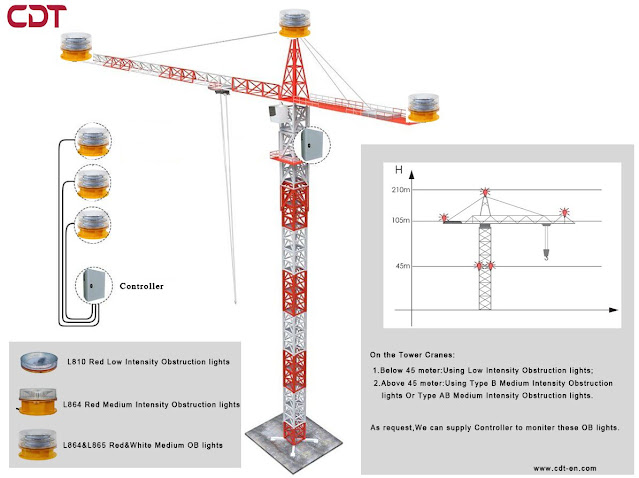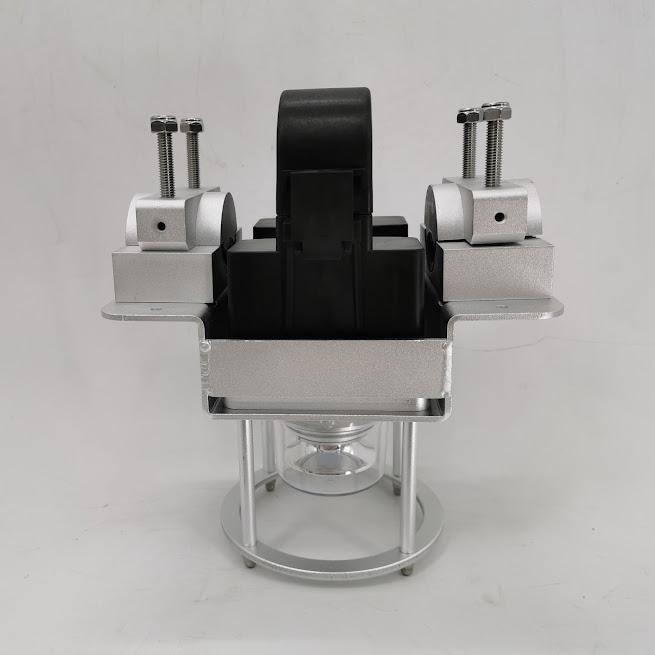LED Tower Crane Lights | Aircraft Warning Lights on Tower Crane
Tower Crane Lights: Tall structures like large buildings and towers aren’t built in a single week or month. It takes a huge amount of effort and time in order to build one.
When these kinds of structures are being constructed, the need for temporary cranes arises, as they are really a great help in speeding up the building process.
The cranes beaconing is mandatory when the building site is located near an airport or heliport, or air navigation routes.
Even if in most cases the cranes are considered as temporary obstacles, the cranes beaconing remains compulsory.
Obstruction lights are also necessary on cranes even if the machines are not in use (nights and week-ends).
Tower crane lighting requirements
Cranes Main Role in Construction – Tower crane lighting requirements.
A crane is a type of machine that uses one or more simple machines to create mechanical advantage and move heavy loads. It is mainly used for lifting and lowering construction materials and transporting them from one place to another.
Construction of large infrastructures and buildings requires a lot of materials to be used, and most of them are so heavy that transporting them from one place to another requires a lot of time.
In this case, the use of cranes speeds up the transporting and lifting process in which manpower alone would not suffice. Tower cranes are one of the types of cranes that offer the best combination of height and lifting capacity and are mainly used in the construction of tall buildings.
As with any tall structure, the presence of a single or a number of cranes has the potential to cause an accident and be an air navigation obstacle. As a solution to this potential danger, cranes are installed with obstruction lights for increased conspicuity, especially for night time operations.
Aviation light for tower crane
Aircraft warning lights on tower cranes
According to Federal Aviation Administration (FAA) and International Civil Aviation Organization (ICAO) tower lighting requirements, all structures exceeding 200 feet above ground level (AGL) must be appropriately marked with tower lights or tower painting. In addition, the Federal Communications Commission governs monitoring requirements.

Tower crane aviation lights
Types of Obstruction Lights Used In Cranes
Tower cranes with a height of less than 150m may require obstruction lighting only if they are considered a significant navigational hazard. However, if a tower crane’s height is 150m or more and is not near an aerodrome, CAA (Civil Aviation Authority) requires the use of obstruction lights.
- Low Intensity Steady Red Lights
Low-Intensity Steady Red Lights – Cranes that are 60 meters to 90 meters high are installed with low intensity steady red lights with a minimum luminous intensity of 32 candelas. They are positioned as close as possible to the highest point. And for tower cranes, they are positioned to the top of the fixed structure so that when displayed especially at night, it will be visible from all directions.
- Medium Intensity Steady Red Lights
Medium Intensity Steady Red Lights (for cranes between 90m to 150m high) – Cranes that are between 90 meters and 150 meters high are also equipped with medium intensity steady red lights that are positioned at the highest point and both ends of the crane jib. The lighting will be an indication of the crane’s height and as well as the radius of the crane jib. These obstruction lights are also displayed at night and are positioned to a place where it can be visible from all directions.
- Steady Red Lights
Medium Intensity Steady Red Lights (for cranes with a height of 150m and above) – This type of obstruction light is usually mounted or positioned as close as possible on the top of the crane at an intermediate level not exceeding 52 meters, and has a luminous intensity of 2000 candela. These obstruction lights are lit at night (Night is defined for civil aviation purposes as the time from half an hour after sunset until half an hour before sunrise).
Guidelines for night marking cranes
Since there is such a variance in Cranes, each case should be assessed individually.
Cranes segment is enormous: from floating cranes to mobile cranes, to tower cranes, to telescopic cranes, to self-erecting cranes, to level luffing cranes, to deck cranes, to jib cranes, to loader cranes, to stacker cranes.
There is no single standard defining minimum mandatory requirements governing design and installation of obstruction lighting; on the other hand, the most common and widespread regulations are ICAO’s and FAA’s.
- Lights and their arrangement on the crane shall be such that the structure is indicated from every angle in azimuth.
- The number of lights to be installed at the top and at each level depends on the type of crane.
- The number of light levels depends on the height of the structure.
| H=height | Number and types of lighting |
| h < 45 m | 1 level of low-intensity obstruction lights shall be used |
| 45m < H < 105m | 2 levels of obstruction lights shall be used: |
| top-level with medium intensity. | |
| intermediate with low intensity. | |
| 105m < H < 210m | 4 levels shall be used: |
| top with medium intensity. | |
| 1st intermediate with low intensity. | |
| 2nd intermediate with medium intensity | |
| lower level with low intensity |








评论
发表评论